engineering encounters
Engaging With Engineering
Science and Children—January/February 2022 (Volume 59, Issue 3)
By Evan Jorgenson and Jerrid Kruse
teaching teachers
Engineering Like a Bird
Science and Children—January/February 2022 (Volume 59, Issue 3)
By Sagan Goodpaster and Rebecca Krall
cross-curricular connections
A “Meteor” Crashed Into Our School!
Engaging children in science with an immersive scenario
Science and Children—January/February 2022 (Volume 59, Issue 3)
By Dana Zeidler, Mitch Ruzek, and Melanie Kinskey
feature
Assessment for English Learners
An illustration of four types of formative assessment in a fifth-grade physical science unit
Science and Children—January/February 2022 (Volume 59, Issue 3)
By Lorena Llosa, Scott E. Grapin, and Alison Haas

feature
Science Day and Night
Embedding nocturnal animal science centers in a 5E inquiry for young learners
Science and Children—January/February 2022 (Volume 59, Issue 3)
By Laura B. Schneider and Stephanie Grable

Feature
Designing for Future Action
How STEAM Programming Can Support Youth Engagement in Community Changemaking Projects
Connected Science Learning January–February 2022 (Volume 4, Issue 1)
By Mairéad Hurley, Abby Rhinehart, Philip Bell, Autumn Brown, Nancy Price, and Joseph Roche

Emerging Connections
Commitments for Connected STEM
Spanning Disciplines, Generations, and Anchor Institutions for Humane Science
feature
Student Agency Through Engineering
When students are given opportunities to address problems important to them, the engineering design process (EDP) helps show the way.
Science and Children—January/February 2022 (Volume 59, Issue 3)
By Shiela Lee, John Russell, Todd Campbell, and Okhee Lee

Brief
What If We Made Room for Young People?
Rebuilding Community-Institution Trust Through Youth Participatory Action Research
Volume 4, Issue 1
Youth and Communities Taking Action Through STEM
Volume 4, Issue 1
Youth and Communities Taking Action Through STEM
Volume 4, Issue 1
Youth and Communities Taking Action Through STEM




